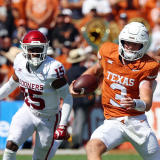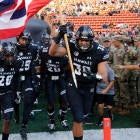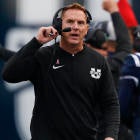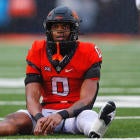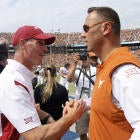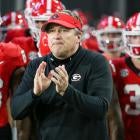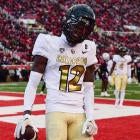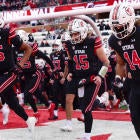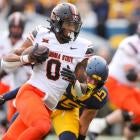Russell Okung called it his "hustle," standing outside the Oklahoma State Student Union asking for a little charity.
"I'd say, 'Hey, I see you're buying detergent,'" said the two-time All-American offensive tackle. "'Why don't you get an extra one [for me]?' They'd kind of smile and say, 'Why not?'"
That's how the Big 12's 2009 offensive lineman of the year made ends meet. Going into his senior season in Stillwater, Oklahoma, Okung had $100 in his bank account. His mother had lost her job. At that point, roommates were pitching in, buying him food for the apartment. Any financial aid he received, Okung sent back home.
"I remember my car broke down. It's probably still at the campus right now," said Okung, now a 10-year NFL veteran. "I didn't have enough money to get it towed. They were calling me to come get it. I didn't have cash. I didn't have insurance."
Okung does have a cause, though, uncommon to most pro-athlete multi-millionaires. The two-time Pro Bowler and Super Bowl champion has become the latest face of the college athlete struggle for the rights to their name, image and likeness (NIL).
This week he was featured in The Players' Tribune writing on the subject.
He testified in support of a California bill that would allow college athletes to profit off their NIL.
To those who had similar struggles -- kindly begging for laundry soap -- perhaps the time has come. It just feels like something is going to change in one of the biggest amateurism crossroads in NCAA history.
The mere fact the NCAA created a working group to study NIL in May shocked many.
"The group's work will not result in paying students as employees," Ohio State athletic director Gene Smith said, the working group's co-chair. "That structure is contrary to the NCAA's educational mission and will not be a part of this discussion."
Who said anything about writing checks? The answers -- if you dig deep enough -- are layered, nuanced and perhaps fair.
For every court case brought against the NCAA amateurism model, that same model seems to survive in some form.
But for decades, college athletes signed away their birthright when they signed a National Letter of Intent. That meant, the NCAA was able to use highlights of Barry Sanders (or Russell Okung) with impunity in commercials, while the players who produced those feats got nothing.
In most states -- in the real world -- you can be sued for profiting off of someone's name, image and likeness. Since 2014, the NCAA has twice been found in violation of federal anti-trust laws. However, its NIL restrictions remain in place. Any player attempting to profit off what is his from the crib remains a rule breaker.
That makes Okung's decade-old "hustle" more likely today than any player launching a YouTube channel to profit off of, say, his rap talents.
"I figured it was just college," said Okung, now vice president of the NFL Players Association. "When you take a step back, you're like, 'I can't believe that I was living at that level.' But I was producing a tremendous amount of value for my school."
All of it goes back to the inherent conflict of big-time college sports. The for-profit business model of the athletic department butting up against the non-profit amateur model adhered by the NCAA.
It just might be one of the most important standoffs in NCAA history. How -- it might be argued -- do players not get part of the college athletics pie that includes a $20 million bonus for a conference commissioner (Big Ten's Jim Delany)?
In the middle of college athletics' comparatively unregulated pot of money are the players who help generate the NCAA's $1 billion in annual revenues. Unregulated? No one stopped Dabo Swinney from becoming the highest-paid coach of all time in April ($92 million over 10 years).
A free market dictates you're worth what someone will pay you. NCAA rules basically restrict compensation to room, books, board, tuition and cost of attendance.
While at UCLA three years ago, Josh Rosen put that dichotomy in perspective. A child of wealth described players who couldn't make rent sleeping in the team room.
Last year, Rosen released a detailed report on how players could share in NIL revenues.
Okung is the latest activist to speak out against a system that critics see as slowly eroding to irrelevance. In March, a judge in Alston vs. NCAA ruled the NCAA can't cap athlete compensation "tethered to education."
If the California bill passes, NCAA President Mark Emmert essentially threatened California schools and their athletes would be barred from NCAA championships. The bill is due to become law in 2023.
The status quo has never felt more vulnerable. Without saying it outright, Emmert was also threatening institutions like the Rose Bowl, not just a staple in California but in college athletics.
A side note Emmert might want to consider: World Wars have failed to cancel the Rose Bowl.
"When I see him make a response like that, I see fear," Okung said. "I see an industry that has been getting away with mob behavior for a very long time. This is coming to roost."
On one hand, it can be argued players have never been treated better. Because of NCAA legislation, the training table has basically become a nutritionally-balanced four-star restaurant that offers three square meals a day. Since 2015, players have been allowed that monthly cost of attendance stipend.
NCAA funds cover parents' trips to the NCAA Tournament. The Student-Athlete Assistance fund pays for insurance premiums for players entering the NFL Draft.
In March, Judge Claudia Wilken spent part of her decision in that Alston case telling the NCAA those myriad benefits already add up to "pay for play."
LSU long snapper Blake Ferguson says he "makes" the equivalent of $12,000 per year. Through his various scholarship checks and cost of attendance stipends he has been able to save up a sizable nest egg for post-graduation.
That doesn't mean the system works. A Pac-12 study found that athletes average 50 hours a week working on their sport. That's before cracking a book.
A survey released last week showed that almost 60 percent of college trainers reported getting pressure from an administrator or coach that was not in the best interest of the athlete's health.
Legislation had to be passed that no practice begin after midnight or before 6 a.m.
"I'm so thankful for everything I've been provided here," Ferguson said. "I'm going to be walking away 4.5 years later with two degrees, no student loans, no debt. It's such a blessing to do what we do. They pay for our food. They pay for everything. Whatever my insurance doesn't cover, LSU covers.
"But I do think there's room for athletes to benefit from the amount of money that is being made based on what we do."
Athletes should at least be able to own that essential part of themselves -- their NIL. That doesn't necessarily mean a windfall. The popular EA Sports NCAA Football video game went way in 2014. Because of the landmark O'Bannon vs. NCAA lawsuit, there was too much liability for the manufacturers.
What if college football players were allowed to collectively license the cover of that game? It's their likenesses on the screen. (The game manufacturers originally got around NCAA restrictions by leaving names off the players. However, their distinct human qualities were obvious.)
"The guys that are on the video game look just like us," Ferguson said. "You go in and look at Trevor Lawrence. He's going to have the long blonde hair. At the end of the day, it is using our likeness to profit. I think the players deserve that."
If the players controlled their NIL, they theoretically could sell the rights to the football game's cover. Let's say they get $20 million. Divide that number by the total number of FBS players (approximately 105 per team times 130 teams). That's 13,650 players.
That comes to an average of $1,465 per player. To appease the NCAA, the money -- again, not a windfall -- would be held in escrow until a player exhausts his eligibility.
It's hard to envision the NCAA amateurism model crumbling.
"The only way to do it is by wealth redistribution," said former Alabama quarterback Greg McElroy. "Just like the NFLPA pays everyone for Madden. Tom Brady gets the same amount as I did, $8,500 or whatever it was. That was the licensing for Madden, maybe some royalties for cards."
McElroy played in two career NFL games, starting one in 2012. After that season, he received a mystery check for $27,000. It was part of the NFL's Performance-Based Pay Distribution explained here.
Those who perform above their prescribed salaries get incentive checks.
"For the college model, you could do it the same way," McElroy said. "The guys who are playing the most snaps are probably the most highly publicized."
If that sounds too outlandish, consider the NCAA's repeated court testimony against compensating players any further: It would tear a locker room apart with jealousy and infighting.
Last year, Oklahoma's Kyler Murray essentially became college sports' highest-paid athlete ever. He received part of a $4.6 million baseball bonus from the Oakland A's before switching full-time to football.
While pocketing a portion of that bonus, Murray led Oklahoma to the College Football Playoff and won the Heisman Trophy. There were no reports of locker room strife.
"The only way I can see it being done is if the universities or the conferences or the NCAA takes the initiative and creates a fund," McElroy added. "At the end of the year, all the money that's in that fund gets redistributed.
"The only way to do it is for the NCAA to take it as one giant umbrella. You play Division I football, you account for this much of the pie. Every single player, however many tens of thousands of players, everyone gets a check."
What about the other sports? If it takes including sand volleyball players sharing with football players, so be it. This could/should be about all NCAA athletes being able to share autograph, YouTube channel and licensing money.
But on some level, this about athletes getting that NIL birthright, not necessarily that windfall.
"It's about basic civil liberties," Okung said. "No where else in our society, aside from prison systems, do we keep people from going into the free market. We don't challenge how much coaches make or administrators make. The free market speaks for itself."
One Power Five commissioner asked if players get their NIL rights, "where does it end?"
The same might be asked of those coaches salaries. The free market is conveniently cited when Swinney breaks the bank or Jimbo Fisher gets $75 million over 10 years. When a football player might get a check for $1,500 at the end of his eligibility, suddenly it's a threat to amateurism?
"It's not solely about paying players or not," Okung said. "It's about how much do you care and respect for these people as a person."


